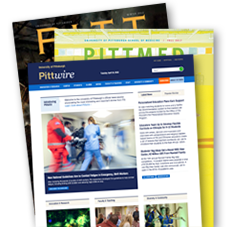U.S. Senators Announce Free Download of Pitt-Carnegie Mellon Biomedical Security Monitoring Software
December 2, 2002
PITTSBURGH—Software that detects a sudden increase of symptoms indicative of a possible bioterrorist attack is immediately available free of charge to any public health organization, U.S. Senators Arlen Specter (R-Pa.) and Rick Santorum (R-Pa.) announced today in conjunction with the BioMedical Security Institute (BMSI), a joint collaboration of the University of Pittsburgh and Carnegie Mellon University.
The software, developed by BMSI, is at http://www.health.pitt.edu/rods. Although the software is free, a simple licensing agreement is required.
The announcement was made during a news conference this morning at Pitt's Biomedical Science Tower on Lothrop Street in Oakland, following a demonstration for the senators of the software, known as the Real-time Outbreak and Disease Surveillance System (RODS).
Also speaking at the news conference were Pitt Chancellor Mark A. Nordenberg; Carnegie Mellon President Jared L. Cohon; Arthur S. Levine, M.D., senior vice chancellor for Health Sciences and dean of the School of Medicine at Pitt; Michael Wagner, M.D., codirector of BMSI, director of BMSI's RODS Laboratory, and an associate professor of medicine and intelligent systems at Pitt; and Andrew Moore, codirector of BMSI and the A. Nico Habermann Associate Professor of Robotics and Computer Science at Carnegie Mellon's School of Computer Science.
RODS software can be used by health departments or urban regions to monitor deidentified emergency department visit abstracts in real time for trends and anomalies suggestive of disease outbreaks—looking, for example, to find symptoms of flu, respiratory illnesses, diarrhea, and skin rashes. A sudden increase in any of these symptoms might indicate a bioterrorist attack. It is now in use at hospitals throughout Pennsylvania and Utah.
Using data that indicate spatial distributions of cases, RODS software can assist public health officials to identify the location of an outbreak. A spike in hospital admissions from a neighborhood, or a message that something is strange by RODS standards, could merely indicate the presence of a flu bug. Or it could mean that a chemical or biological weapon has been released. Based on these analyses, RODS generates alerts about public health conditions and sends them by pager to designated personnel.
Specter, the ranking member of the U.S. Senate's Labor-Health and Human Services Appropriations Subcommittee, and Santorum, a member of the Senate's Armed Services Committee, provided important support to BMSI at its inception in 2000.
Funding for the RODS system and other biodefense-related research at Pitt and Carnegie Mellon was provided by the Centers for Disease Control and Prevention, with additional funding coming from the Agency for Healthcare Research and Quality. Subsequent support for RODS was provided by the Defense Advanced Research Projects Agency and, most recently, by the Pennsylvania Department of Health to build an early warning public health surveillance system throughout the state of Pennsylvania.
RODS was demonstrated Feb. 5 for President George W. Bush, Homeland Security Director Tom Ridge, and Health and Human Services Secretary Tommy Thompson in conjunction with their visit to the University of Pittsburgh. Following the demonstration, Bush, in an address at Pitt's Alumni Hall, called the system the modern "DEW line," referring to the Distant Early Warning radar system employed during the Cold War to guard against an attack from the Soviet Union. "I've come to realize," he said, "that while Pittsburgh used to be called Steel Town, you need to call it Knowledge Town."
RODS was employed later in February for surveillance during the Winter Olympic Games in Salt Lake City.
The RODS software, written in the Java computer language and thus hardware independent, is downloadable for noncommercial use by public health departments and urban regions.
It is available in three software packages.
• CoCo (Complaint Coder) is a program that converts free-text chief complaints into prodromic categories. CoCo is a key element in a prodromic surveillance system, and it is available to other developers of public health surveillance systems to include in their systems.
• RODS 1.0, which includes CoCo, is the same software system that was used for surveillance during the Winter Olympic Games. Once installed at a health department, the software can begin automatic data collection and analysis, including mapping and timegraphing trends. RODS 2.0 is scheduled to be released this spring; it will include functions for analysis of retail and poison center data relevant to public health surveillance.
• The third package, called WSARE 2.0 (What's Strange About Recent Events), is research software for detecting and evaluating the strangest daily emerging patterns in surveillance data, available at www.autonlab.org/wsare.
RODS is an academic collaboration involving health departments, hospitals and medical centers, foundations, and industries throughout Pennsylvania.
###
Media Resources
Schools of the Health Sciences Media Relations
For more information about Pitt's schools of dental medicine, health and rehabilitation sciences, medicine, nursing, pharmacy, and public health, click here >
To locate stories from health science schools prior to 2013, visit the UPMC news archives »
Urgent Question?
University of Pittsburgh news reps are available to answer urgent media inquiries. Outside of regular business hours (Mon-Fri, 8:30 a.m.-5 p.m.), please email us at media@pitt.edu.
News reps for University of Pittsburgh Health Sciences schools can be reached outside of regular business hours through the paging operator at 1+412-647-2345.


